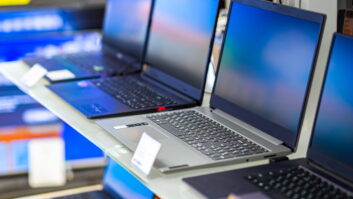Melville, N.Y. – Options are growing for consumers who want to use their home’s landline phones to send and receive cellular calls.
Two companies — WHP Wireless, based here, and Phone Labs of Bridgeport, Conn. – are expanding the selection of cellular phones that work with cellphone-docking devices that link a cellular phone to a home’s telephone wiring.
On two-line home-phone systems, the devices let consumers create a dedicated cell phone line on the second line while maintaining standard landline service on the first. Consumers can also opt to disconnect local landline service entirely, either in a primary residence or in a second home. In any of these applications, consumers can use more ergonomic home phones to take advantage of cellular rate plans that offer free mobile-to-mobile calls, provide free night and weekend calls, and include long distance in their per-minute charges.
With consumers now allowed to transfer their home number to a cellular phone, device suppliers expect landline replacement to drive a growing percentage of their business.
“Today, cellular service is affordable enough to allow users to treat their cellular phone as a replacement for their long-distance carrier or even to replace their regular phone line,” said Nancy Juarbe, WHP marketing director.
Although consumers already use cellphones inside their houses, she and Phone Labs president Carl Lopp point out that cellular service often weakens at various locations inside a house. The WHP and Phone Labs devices overcome that challenge by letting users dock a cellphone into a home’s landline wiring at locations where cellular reception is strongest. Users also don’t have to search for their cellphone each time an incoming call is received, they added.
To expand the sales potential of its Motorola-dedicated Cellsocket device, WHP plans early July availability of an adapter that will expand Cellsocket’s compatibility to 16 Motorola cellphones from 13. In the next two months, Phone Labs plans to expand the compatibility of its Dock-n-Talk device to 200 to 250 phone models, up from a current 150 Sony Ericsson, Motorola, and Nokia phones. With the upgrade, the device will be compatible with additional phones from the three brands and with select other-brand phones.
Both companies’ devices also recharge a cellphone’s battery.
Here’s what the two companies plans:
Phone Labs
: The supplier overcame SARS-induced production delays at an Asian factory to begin January shipments of Dock-n-Talk through phonelabs.com and other web sites, including cellantenna.com. Sometime later this month, Carl Lopp, company president, will announce distribution through a major retail chain.
Dock-N-Talk consists of the $139-suggested docking station/recharger that connects to cellphones via separately sold adapter cables. Three cables are available: one for Sony Ericsson phones at $14.99, one for Nokia phones at $14.99, and one for Motorola phones at $17.99. A $69.99 Bluetooth model that just became available will let Bluetooth-equipped phones connect automatically to Dock-N-Talk as soon as they get within range.
Besides letting consumers access a cellular network through their home phones, Dock-n-Talk also lets users access cellular phone features through their home phone. Caller-ID-equipped home phones, for example, display the caller ID numbers of incoming cellular calls, and consumers are able to cellphone features such as voice dialing and one-touch dialing through a home phone.
When the docking station is used in homes with two-line phones, the phones will ring to alert users to either an incoming landline call or an incoming cellular call. If all phones in a house are single-line phones, consumers can plug each phone into a line splitter, at a cost of about $8, and designate only certain phones to ring for an incoming cellular call.
Consumers can also convert their single-line phones into two-line phones by plugging them into a $20-$30 two-line switch.
The docking station can also be plugged directly into a phone in a one-phone household or in college dorm rooms.
In August, Phone Labs hopes to ship another option that was delayed because of SARS. It is the $199-suggested SOHO-targeted two-line corded desk phone. Called Unity, it dedicates one line to landline service and the second line to cellular service when a cellphone is docked via one of the phone-adapter cables or Bluetooth module.
Unity doesn’t link a cellphone to other phones in the house, but from Unity, users can access more cellphone features than they could through a residential phone linked to Dock-N-Talk. The accessible features include SMS and predictive text input. For example, users can view cellular SMS messages on the desk phone’s larger LCD display. Consumers can also tap out an SMS message on the desk phone’s larger keys, taking advantage of the cellphone’s predictive text-entry technology if the cellphone is so equipped. The Unity phone also captures and displays the cellphone’s directory and integrates it into the Unity’s directory.
Also in August, Phone Labs plans to offer a $169 version of the Unity phone. Called the Enterprise phone, it offers all Unity features but the ability to connect to a landline network. It’s intended for businesses or organizations that don’t need a landline connection., They would include disaster-relief agencies that set up temporary headquarters, Lopp said.
WHP Wireless:
At a suggested $139.99, Cellsocket includes an integrated antenna to boost signal strength by “two bars,” said marketing director Juarbe. It’s available through WHP’s Web site as well as through distributor CTDI of West Chester, Pa.
The price includes the base and one of several adapters, each designed for select Motorola phones. The company is developing other bases for other cellular brands, she added without revealing a timeline.
Four adapters currently available link the base to 13 Motorola handsets: the T720 and T720c, T721, T722i, T730, T730c, T731, all three V60 series phones, and all three V120 series phones, said Juarbe. In early July, a fifth base will permit use of the V300, V400, and V600 phones.
Connected home phones can take advantage of such cellphone features as caller ID, one-touch dialing, voice dialing, and call conferencing and waiting but not text messaging.
Cellsocket features an external antenna that boosts the cell phones existing signal by at least two bars.
WHP’s majority investor is Jeff Pulver, co-founder and minority shareholder in Vonage, the voice-over-Internet-protocol (VOIP) provider, and the founder of Free World Dial-Up, a service that lets consumers make free calls anywhere in the world over a PC.













